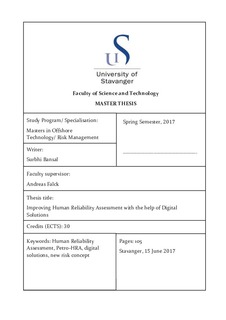| dc.description.abstract | It has been observed that humans have played a big role in many past major accidents
in escalating a chain of events into a full-fledged disaster. However, it needs to be
recognised that the human operational barrier element can affect the risk level both
positively and negatively. Understanding the human performance in a post- initiating
event scenario and how this can be included in risk assessment is therefore important.
In this thesis, we are attempting to understand the role of human reliability assessment
(HRA) in reducing the uncertainties introduced due to human operational element and
the effectiveness of current risk assessment tools in capturing human performance
within the scope of the new risk concept. This thesis also tries to discuss and present a
way in which digitization can help to improve the current risk analysis method
incorporating HRA.
Study of investigation reports, literature review, interviews and discussion with
industrial experts and reviewing the case study in the Petro-HRA guidelines are used
throughout the research process of this report to reach logical conclusions.
The first chapter defines the objective, motivation and scope of the thesis. In the second
chapter, we conduct a literature review of the current and the new risk concept, human
reliability assessment techniques used across the industries and conduct interviews of
industrial specialists from the oil and gas sector. These insights help us to understand
the current HRA’s developmental stage in Norway, its perceived limitations and
background. In the third chapter, various investigation reports have been reviewed to
understand the role and cause of human performance in the past accidents. Also,
various risk indicators have been discussed for their ability to capture human
performance. The fourth chapter reviews current risk assessment practices for their
applicability, methodology and weaknesses with respect to HRA requirements. The fifth
chapter proceeds towards understanding the HRA integration with quantitative risk
assessment (QRA), practical limitations, data requirements, modelling Human Failure
Events (HFEs) and uncertainties in HRA guidelines. These have helped us to find out
gaps and areas in the Petro-HRA guidelines, which require improvement or further
research. The sixth chapter introduces the digitisation in oil and gas sector. Here, we
present a digital solution encompassing a Multiplier Model as a solution to the
highlighted gaps along with its associated assumptions, simplifications and challenges.
Finally, the thesis ends on chapter seven by suggesting a few other alternate directions
of research which were identified during the study as holding some potential for
improving the HRA framework further. | nb_NO |
